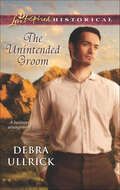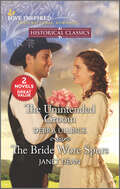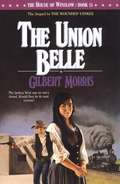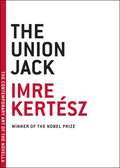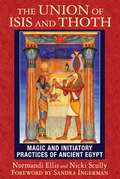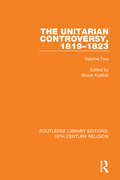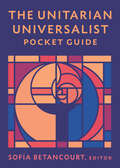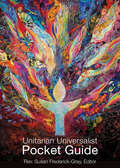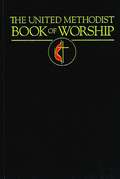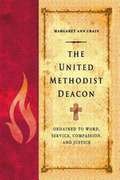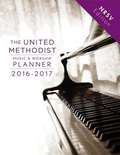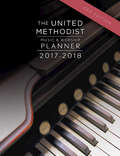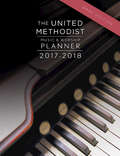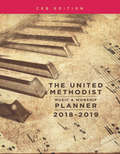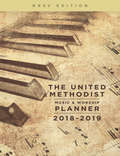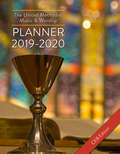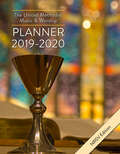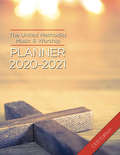- Table View
- List View
The Unintended Groom
by Debra UllrickA Perfect PartnershipWhen Abby Bowen's dream of love is dashed, she pursues a new dream: opening a dinner theater in Hot Mineral Springs, Colorado. There's just one hitch; she needs a male business partner. The handsome father of twins who answers Abby's ad is perfect...perhaps too perfect. Working with someone like Harrison Kingsley-without losing her heart-will be harder than Abby anticipated.It's a good thing Harrison's arrangement with Abby is strictly business. Because with her kind soul, smiling blue eyes and gentle way with his boys, he could easily fall for her. But the longer he works with Abby, the more Harrison realizes that the Lord might have an entirely different partnership planned for them.
The Unintended Groom and The Bride Wore Spurs
by Janet Dean Debra UllrickA perfect partnershipThe Unintended Groom by Debra UllrickWhen Abby Bowen's dream of love is dashed, she pursues a new dream: opening a dinner theater in Hot Mineral Springs, Colorado. There's just one hitch: she needs a male business partner. The handsome father of twins who answers Abby's ad is perfect…perhaps too perfect. Working with someone like Harrison Kingsley—without losing her heart—will be harder than Abby anticipated!The Bride Wore Spurs by Janet DeanTo keep the Texas ranch she loves, Hannah Parrish will wed a man she doesn't. Cowpokes won't take orders from a young, single female. But while her exasperating neighbor, Matt Walker, jokes about her being a mere debutante, Hannah is a rancher to the core. Now Matt must convince her the greatest strength comes in trusting your heart to another—and your future to God…
The Unintended Reformation: How a Religious Revolution Secularized Society
by Brad S. GregoryIn a work as much about the present as the past, Gregory identifies the unintended consequences of the Reformation for the modern condition: a hyperpluralism of beliefs, intellectual disagreements that splinter into fractals of specialized discourse, the absence of a substantive common good, and the triumph of capitalism’s driver, consumerism.
The Unintended Reformation: How a Religious Revolution Secularized Society
by Brad S. GregoryIn a work that is as much about the present as the past, Brad Gregory identifies the unintended consequences of the Protestant Reformation and traces the way it shaped the modern condition over the course of the following five centuries. A hyperpluralism of religious and secular beliefs, an absence of any substantive common good, the triumph of capitalism and its driver, consumerism—all these, Gregory argues, were long-term effects of a movement that marked the end of more than a millennium during which Christianity provided a framework for shared intellectual, social, and moral life in the West. Before the Protestant Reformation, Western Christianity was an institutionalized worldview laden with expectations of security for earthly societies and hopes of eternal salvation for individuals. The Reformation’s protagonists sought to advance the realization of this vision, not disrupt it. But a complex web of rejections, retentions, and transformations of medieval Christianity gradually replaced the religious fabric that bound societies together in the West. Today, what we are left with are fragments: intellectual disagreements that splinter into ever finer fractals of specialized discourse; a notion that modern science—as the source of all truth—necessarily undermines religious belief; a pervasive resort to a therapeutic vision of religion; a set of smuggled moral values with which we try to fertilize a sterile liberalism; and the institutionalized assumption that only secular universities can pursue knowledge. The Unintended Reformation asks what propelled the West into this trajectory of pluralism and polarization, and finds answers deep in our medieval Christian past.
The Union Belle (House of Winslow, #11)
by Gilbert MorrisAs the nation recovers from the Civil War, Sky and Rebekah Winslow's wayward son Mark is slowly making his way north through Texas after his release from a Mexican prison. Headed for Omaha to work for the Union Pacific Railroad, he is forced to shoot a man, then thrown in jail to await his prison sentence. In a small Texas town where justice will not be served, Mark's only hope is the young woman whom he defended.
The Union Jack
by Tim Wilkinson Imre Kertesz"It was...unnecessary for me to fret about who the murderer was: Everybody was."A haunting, never-before-translated, autobiographical novella by the 2002 Nobel Prize winner. An unnamed narrator recounts a simple anecdote, his sighting of the Union Jack--the British Flag--during the Hungarian Revolution of 1956, in the few days preceding the uprising's brutal repression by the Soviet army. In the telling, partly a digressive meditation on "the absurd order of chance," he recalls his youthful self, and the epiphanies of his intellectual and spiritual awakening--an awakening to a kind of radical subjectivity. In his Nobel address Kertesz remembered: "I, on a lovely spring day in 1955, suddenly came to the realization that there exists only one reality, and that is me, my own life, this fragile gift bestowed for an uncertain time, which had been seized, expropriated by alien forces, and circumscribed, marked up, branded--and which I had to take back from 'History', this dreadful Moloch, because it was mine and mine alone..."The Contemporary Art of the Novella series is designed to highlight work by major authors from around the world. In most instances, as with Imre Kertész, it showcases work never before published; in others, books are reprised that should never have gone out of print. It is intended that the series feature many well-known authors and some exciting new discoveries. And as with the original series, The Art of the Novella, each book is a beautifully packaged and inexpensive volume meant to celebrate the form and its practitioners.
The Union of Dzogchen and Bodhichitta: A Guide to the Attainment of Wisdom
by Anyen RinpocheAn illuminating look at key aspects of Tibetan Buddhist practice--of interest to many practitioners--is presented in this practical and interesting book. Through demonstrating the interrelationship of the outer inner and secret teachings and a textual analysis of the words of four renowned Dzogchen yogis, it makes clear that the practice of Bodhichitta is a necessary aspect of every practice within Tibetan Buddhism. <P><P>Unlike other books that present either the teachings of Bodhichitta or the teachings of Dzogchen as their own system of practice, this book presents them not as complementary practices but as a deconstructed inner and outer practices which are fundamentally intertwined. Anyen Rinpoche works to create a new generation of holistic practitioners who value the depth found in the entire spectrum of teachings. <P><P>While Anyen Rinpoche acknowledges the profundity of the Dzogchen teachings, he dispels the myth that they are an effortless path to liberation and rather shows that they are a progressive path that requires diligence, insight, and the compassionate mind of a Bodhisattva. He presents a style of contemplation that combines Dzogchen meditation on the ultimate view with the generation of Bodhichitta, such as has been taught by Nyingmapa yogis throughout the centuries. This book presents the union of Dzogchen and Bodhichitta not only through philosophy and scripture but also through concrete methods for practice.
The Union of Isis and Thoth: Magic and Initiatory Practices of Ancient Egypt
by Sandra Ingerman Nicki Scully Normandi EllisAn initiatic guide to temple construction on the spiritual and physical planes • Details the initiations for consecrating yourself as a divine vessel • Guides you in building a sacred inner temple for connecting with the gods of Egypt • Delivers shamanic journeys and initiations on ascension, shamanic death and renewal, soul retrieval and healing, multidimensional realities, and more Deep within each of us lives a primal memory of a time when the natural world was recognized as divine and our temples were built from sacred materials enlivened through magic. Temples were not places you visited once a week; they were centers of community, divine work, healing, and wisdom, places where Heaven and Earth meet. This union of Heaven and Earth--the sacred temple--is also a union of Thoth and Isis: the Egyptian god of wisdom and the creative cosmic force and the Egyptian goddess of civilizing knowledge. Their relationship established the celestial teachings on Earth, for Thoth taught Isis all the mysteries and magic she knows and Isis acted as Thoth’s instrument to deliver the teachings in a form humanity could use. In this initiatic guide to temple building on the spiritual and physical planes, Normandi Ellis and Nicki Scully explain how to create a communal spiritual structure for connecting with the ancient Egyptian pantheon as well as how to consecrate yourself and become a vessel suitable for divine wisdom and a home for your personal gods. The authors detail the construction, shamanic visioning, and ritual consecration of a Moon Temple dedicated to Thoth. They explore teachings that help you develop relationships with the Egyptian neteru and realize your place within the family of the Egyptian pantheon. They guide you as you create your inner heart temple, the adytum, a safe place in which to receive guidance and access your higher spiritual bodies and oracular gifts. They provide shamanic journeys and initiations on ascension, shamanic death and renewal, soul retrieval and healing, multidimensional realities, and more. By creating a sacred temple within and without, we each can take part in the union of Isis and Thoth and restore the magic of the Egyptian mysteries to our time.
The Unitarian Controversy, 1819-1823: Volume One (Routledge Library Editions: 19th Century Religion #10)
by Bruce KuklickOriginally published in 1987. The dispute between Leonard Woods, an American theologian and well known Calvinist, and Henry Ware, a preacher and theologian influential in the formation of Unitarianism, went on for four years and is reprinted here in its entirety. Although the combatants were concerned over whether God’s nature was one or three, other issues were more important for them, and these issues are discussed at length in their correspondence. This title will be of interest to students of history and religious studies.
The Unitarian Controversy, 1819-1823: Volume Two (Routledge Library Editions: 19th Century Religion #11)
by Bruce KuklickOriginally published in 1987. The dispute between Leonard Woods, an American theologian and well known Calvinist, and Henry Ware, a preacher and theologian influential in the formation of Unitarianism, went on for four years and is reprinted here in its entirety. Although the combatants were concerned over whether God’s nature was one or three, other issues were more important for them, and these issues are discussed at length in their correspondence. This title will be of interest to students of history and religious studies.
The Unitarian Universalist Pocket Guide: Seventh Edition
by Dr Sofía BetancourtA powerful, engaging, and accessible introduction to Unitarian Universalism. Unitarian Universalists are people of all ages, of many backgrounds, and of many beliefs. They are brave, curious, and compassionate thinkers and doers who create spirituality and community beyond boundaries, working for more justice and more love in a hurting world.The Unitarian Universalist Pocket Guide is the most complete introduction to Unitarian Universalism available, covering ministry, worship, religious education, social justice, community, and history. Edited by Rev. Dr. Sofía Betancourt, this seventh edition prepares readers with resources and information for this crucial moment in Unitarian Universalism. Contributors include Rev. Cheryl M. Walker, Rev. Ashley Horan, Rev. Dr. Sheri Prud’homme, Rev. Nancy McDonald Ladd, Rev. Katie Romano Griffin, Dr. Dan McKanan, and Rev. Victoria Safford, among others.
The United Methodist Book of Worship Pastor's Pocket Edition
by Abingdon Press UMPH Methodist PublicationThe Pastor’s Pocket Edition has everything, but the service music, found in the regular Book of Worship. This helpful United Methodist denominational book of liturgy, prayer, and services is indispensable for pastors, musicians, and laypersons that plan and lead worship. Arranged according to the Christian year, this resource enables worship leaders to locate prayers, services, and information quickly. Updated information and new formats insure ease of use, making this a great resource when planning and leading worship.Updates for all formats include:Membership vows, baptismal covenant, diaconal changes, and other updates made as a result of General Conference action.Calendar for dating Easter and related holy days—extend beyond 2020.Chart of lectionary years on page 227--update and extend.Current version of ordinal.Available with all digital formats PDF contents pages--hot linked to each section/item.
The United Methodist Book of Worship: Regular Edition Black
by Various Abingdon Press UMPH Methodist PublicationThis helpful United Methodist denominational book of liturgy, prayer, services and service music is indispensable for pastors, musicians, and laypersons that plan and lead worship. Arranged according to the Christian year, this resource enables worship leaders to locate prayers, services, and information quickly. Updated information and new formats insure ease of use, making this a great resource when planning worship.It features: A vast collection of worship material: services, liturgies, litanies, prayers, blessings, music, and other acts of worship and praise. Thousands of references to The United Methodist Hymnal, including suggested hymns for a host of worship occasions. Resources for special Sundays and other days of churchwide emphasis. New Christian Years Services Services for various occasions including: Presentation of Bibles to Children An Order of Farewell to Pastor Orders of Installation or Recognition Orders of Daily Praise and PrayerUpdates include: Membership vows, baptismal covenant, diaconal changes, and other updates made as a result of General Conference action. Calendar for dating Easter and related holy days—extend beyond 2020. Chart of lectionary years on page 227--update and extend. Current version of ordinal.
The United Methodist Deacon: Ordained to Word, Service, Compassion, and Justice
by Margaret Ann CrainThe United Methodist order of deacon represents the ever-evolving understanding of ordained ministry. But because of the continual changes, there is confusion about the call, roll, identity, and tasks of deacons. With vivid examples, this book gives a clear understanding of the order of deacon, beginning with a discussion of how its unique call sets apart persons for ordained ministry. Contents include:A Deacon Is Called and SentA Deacon Is ConnectionalA Deacon Is MissionalA Deacon Is Examined and EquippedThe Meaning of OrdinationA Deacon Is AppointedDeacons Lead the Church Epilogue: A Snapshot of Deacons and Their Ministry
The United Methodist Hymnal: Book of United Methodist Worship
by The United Methodist Publishing HouseThis is the hymnal of the United Methodist Church as published in 1989. It contains orders of services, all the hymns, the Psalter, prayers and creeds, and indexes. There is no music notation. The DAISY edition is fully marked up for each hymn and Psalter location. At level 1 you can navigate to the major sections listed above. At level 2 you can navigate from hymn to hymn and from one psalter location to another. Or you can type hymn and its number or psalm and its number in either DAISY or BRF files to quickly move to a hymn or psalm. With this electronic edition you can either lead or participate in a hymn sing. The hymn stanzas are in poetry style. Because of the DAISY markup for each hymn and Psalter location, you may find that the BRF file contains a lengthy table of contents showing each psalm and each hymn. The foreign language hymns included are carefully produced so that they are accurate in the newer UEB Braille code.
The United Methodist Music & Worship Planner 2014-2015
by Mary J. Scifres David L. BoneAn all-in-one resource that helps both the music director and pastor plan the worship services for each Sunday and holy day of the year, the United Methodist Music and Worship Planner 2014-2015 is lectionary based and places at one's fingertips a calendar format that helps plan the entire choir year from September through August, reproducible worship planning forms, suggestions for prayers, solos, anthems, visuals, and much more. Also included is the complete lectionary text of the Old Testament, Psalm, Epistle, and Gospel readings.
The United Methodist Music & Worship Planner 2016-2017 NRSV Edition
by Mary J. Scifres David L. BoneAn all-in-one resource that helps both the music director and pastor plan the worship services for each Sunday and holy day of the year, The United Methodist Music and Worship Planner 2016-2017 is lectionary-based and places at your fingertips: Calendar format that helps you plan the entire choir year, from September through August. Eight or more suggested hymns for each service keyed to United Methodist worship resources: The United Methodist Hymnal, The Faith We Sing, Worship & Song, The United Methodist Book of Worship, and The Africana Hymnal. Complete lectionary text of the Old Testament, Psalm, Epistle, and Gospel readings using the New Revised Standard Version of the Bible. Reproducible worship planning forms. Resources for holidays and special days. Suggestions for prayers, solos, anthems, visuals, and much more.
The United Methodist Music & Worship Planner 2017-2018 CEB Edition
by Mary J. Scifres David L. BoneAn all-in-one resource that helps both the music director and pastor plan the worship services for each Sunday and holy day of the year, The United Methodist Music and Worship Planner 2017 - 2018 is lectionary-based and places at your fingertips: Calendar format that helps you plan the entire choir year, from September through August. Eight or more suggested hymns for each service keyed to United Methodist worship resources: The United Methodist Hymnal, The Faith We Sing, Worship & Song, The United Methodist Book of Worship, and The Africana Hymnal. Complete lectionary text of the Old Testament, Psalm, Epistle, and Gospel readings using the Common English Bible Translation. Reproducible worship planning forms. Resources for holidays and special days. Suggestions for prayers, solos, anthems, visuals, and much more.
The United Methodist Music & Worship Planner 2017-2018 NRSV Edition
by Mary J. Scifres David L. BoneAn all-in-one resource that helps both the music director and pastor plan the worship services for each Sunday and holy day of the year, The United Methodist Music and Worship Planner 2017–2018 is lectionary-based and places at your fingertips: Calendar format that helps you plan the entire choir year, from September through August. Eight or more suggested hymns for each service keyed to United Methodist worship resources: The United Methodist Hymnal, The Faith We Sing, Worship & Song, The United Methodist Book of Worship, and The Africana Hymnal. Complete lectionary text of the Old Testament, Psalm, Epistle, and Gospel readings using the New Revised Standard Version of the Bible. Reproducible worship planning forms. Resources for holidays and special days. Suggestions for prayers, solos, anthems, visuals, and much more.
The United Methodist Music & Worship Planner 2018-2019 CEB Edition
by David L. Bone Mary ScifresAn all-in-one resource that helps both the music director and pastor plan the worship services for each Sunday and holy day of the year, The United Methodist Music and Worship Planner 2018-2019 is lectionary-based and places at your fingertips: Weekly pages in spiral-bound format that help you plan the entire worship year, from September through August. Eight or more suggested hymns for each service keyed to United Methodist worship resources: The United Methodist Hymnal, The Faith We Sing, Worship & Song, The United Methodist Book of Worship, and The Africana Hymnal. Complete lectionary text of the Old Testament, Psalm, Epistle, and Gospel readings using the Common English Bible translation. Reproducible worship planning forms. Resources for holidays and special days. Suggestions for prayers, solos, anthems, visuals, and much more. Also available with NRSV texts.
The United Methodist Music & Worship Planner 2018-2019 NRSV Edition
by David L. Bone Mary ScifresAn all-in-one resource that helps both the music director and pastor plan the worship services for each Sunday and holy day of the year, The United Methodist Music and Worship Planner 2018-2019 is lectionary-based and places at your fingertips: Weekly pages in spiral-bound format that help you plan the entire worship year, from September through August. Eight or more suggested hymns for each service keyed to United Methodist worship resources: The United Methodist Hymnal, The Faith We Sing, Worship & Song, The United Methodist Book of Worship, and The Africana Hymnal. Complete lectionary text of the Old Testament, Psalm, Epistle, and Gospel readings using the New Revised Standard Version of the Bible. Reproducible worship planning forms. Resources for holidays and special days. Suggestions for prayers, solos, anthems, visuals, and much more. Also available with CEB texts.
The United Methodist Music & Worship Planner 2019-2020 CEB Edition
by David L. Bone Mary ScifresAn all-in-one resource that helps both the music director and pastor plan the worship services for each Sunday and holy day of the year, The United Methodist Music and Worship Planner 2019-2020 is lectionary-based and places at your fingertips: Weekly pages in spiral-bound format that help you plan the entire worship year, from September through August. Eight or more suggested hymns for each service keyed to United Methodist worship resources: The United Methodist Hymnal, The Faith We Sing, Worship & Song, The United Methodist Book of Worship, and The Africana Hymnal. Complete lectionary text of the Old Testament, Psalm, Epistle, and Gospel readings using the Common English Bible translation. Reproducible worship planning forms. Resources for holidays and special days. Suggestions for prayers, solos, anthems, visuals, and much more. Also available with NRSV texts
The United Methodist Music & Worship Planner 2019-2020 NRSV Edition
by David L. Bone Mary ScifresWorship Planner 2019-2020 is lectionary-based and places at your fingertips: Weekly pages in spiral-bound format that help you plan the entire worship year, from September through August. Eight or more suggested hymns for each service keyed to United Methodist worship resources: The United Methodist Hymnal, The Faith We Sing, Worship & Song, The United Methodist Book of Worship, and The Africana Hymnal. Complete lectionary text of the Old Testament, Psalm, Epistle, and Gospel readings using the New Revised Standard Version of the Bible. Reproducible worship planning forms. Resources for holidays and special days. Suggestions for prayers, solos, anthems, visuals, and much more. Also available with CEB texts.
The United Methodist Music & Worship Planner 2020-2021 CEB Edition
by David L. Bone Mary ScifresAn all-in-one resource that helps both the music director and pastor plan the worship services for each Sunday and holy day of the year, The United Methodist Music and Worship Planner 2020-2021 is lectionary-based and places at your fingertips: Weekly pages in spiral-bound format that help you plan the entire worship year, from September through August. Eight or more suggested hymns for each service keyed to United Methodist worship resources: The United Methodist Hymnal, The Faith We Sing, Worship & Song, The United Methodist Book of Worship, and The Africana Hymnal. Complete lectionary text of the Old Testament, Psalm, Epistle, and Gospel readings using the Common English Bible translation. Reproducible worship planning forms. Resources for holidays and special days. Suggestions for prayers, solos, anthems, visuals, and much more.Also available with NRSV texts
